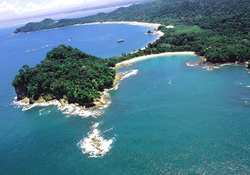
Manuel Antonio National Park, in Spanish the Parque Nacional Manuel Antonio, is a small National Park in theCentral Pacific Conservation Area located on the Pacific coast of Costa Rica, just south of the city of Quepos,Puntarenas, and 132 km (82 mi) from the national capital of San José. Established in 1972 with an area enumerating 4,014 acres (16.24 km2) (the smallest of any Costa Rican national park), it is the destination of as many as 150,000 visitors annually and well-known for its beautiful beaches and hiking trails. In 2011, Manuel Antonio was listed by Forbes among the world's 12 most beautiful national park
BeachesFour beaches are contained within the limits of the park: Manuel Antonio, Espadilla Sur, Teldoro, and Playita. With their large light sand berms, it is easy to see why they attract beach goers of all ages. The first is separated from the second by a "tombolo", or natural land bridge formed by sand accumulations. Visitors may enjoy a roughly hour-long hike from Espadilla to the top of Punta Catedral (100 m). Both Manuel Antonio and Espadilla Sur contain tidal pools and offer the possibility of snorkeling. There is a lifeguard program, but precaution must be taken, as riptides occur. [edit]BiodiversityAlthough Manuel Antonio National Park is Costa Rica's smallest national park, the diversity of wildlife in its 6.83 km2 (3 sq mi) is unequaled with 109 species of mammals and 184 species of birds. Both Brown-throated Three-toed Sloth and Hoffmann's Two-toed Sloth (perezosos) are a major feature, as are three of Costa Rica's four monkey species — the Mantled Howler monkey, Central American Squirrel Monkey, and White-headed Capuchinmonkey. Black Spiny-tailed Iguana, Green Iguana, Common Basilisk, White-nosed Coati and many snake and batspecies are also common in the park. Included in the 184 bird species are toucans, woodpeckers, potoos,motmots, tanagers, Turkey Vulture, parakeets and hawks. Dolphins can be observed there, as well as the occasional migrating whale. Scuba diving, snorkeling, sea kayaking, mountain biking, and hiking provide opportunities to experience the tropical wildlife that enriches Manuel Antonio. Manuel Antonio is Costa Rica's second most visited park behind the Poás Volcano National Park which lies very close to San José, the country's largest urban area. The park's popularity has led to development of the surrounding areas, with environmental impacts to nearby forests and beaches. The Pacific Ocean in front of Manuel Antonio Park is also world renowned for its fishing. From November to April it is not uncommon for a typical angler to release multiple billfish in the over 100 pound range |
-
Major Beaches by Zone
-
Hotels and Restaurants
-
Costa Rica Info
- About Costa Rica
- Costa Rica Map
- Festivals of Costa Rica
-
Costa Rica National Parks
>
- Arenal National Park
- Barbilla National Park
- Barra Honda National Park
- Braulio Carrillo National Park
- Cahuita National Park
- Carara National Park
- Chirripo National Park
- Cocos Island National Park
- Corcovado National Park
- Diria National Park
- Guanacaste National Park
- Irazu Volcano National Park
- Juan Castro Blanco National Park
- La Amistad International Park
- La Cangreja National Park
- Las Baulas National Marine Park
- Manuel Antonio National Park
- Maquenque National Park
- Palo Verde National Park
- Piedras Blanco National Park
- Poas Volcano National Park
- Rincon de la Vieja Volcano National Park
- Santa Rosa National Park
- Tapanti National Park
- Tenorio National Park
- Tortuguero National Park
- Turrialba
- Typical Questions
- International Air Service
- Costa Rica Domestic Air Travel >
- Driving in Costa Rica >
- U.S. Embassy Notices
- Costa Rica Properties
- Community Service
- Costa Rica Golf
- Monteverde Tours
- Costa Rica News
- New Page
